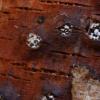
02-01-2026 17:43
MARICEL PATINOHi there, although I couldn't see the fruitbody, I

01-01-2026 18:35
Original loamy soil aside a artificial lake.The co

31-12-2025 19:27
Collected from loamy soil, at waterside (completel

30-12-2025 16:44
Pascal DucosBonjour,Une anamorphe rose stipitée, très nombre

30-12-2025 17:14
 Bernard CLESSE
Bernard CLESSE
Bonjour à toutes et tous,Pourriez-vous aider Albe

29-12-2025 10:15
Hulda Caroline HolteHello, I found and collected this propoloid ascom
Valsa sordida on Populus tremula ?
Peter Thompson,
02-10-2014 20:00
I collected a sample of a stromatic pyrenomycete which has raised the host substrate in a series of pustules, with black ostioles piercing its white discs.
The substrate is noticeably cracked, which, from the information which I have found, I believe to be a characteristic of this fungus when it infects Populus tremula (aspen).
I am thinking that this is Valsa sordida, which also fits with the shape and size of the spores and asci.
I wonder if anyone can confirm this, or otherwise, for me please.
The image of the stromata and the cracking of the wood around them is attached. A sketch of the microscopy is also attached.
Thank You,
With Best Wishes,
Peter.
Eduard Osieck,
05-10-2014 13:37
Re : Valsa sordida on Populus tremula ?
Hi Peter,
The white discs are quite striking. According to Spielman (1975: 1362) V. sordida should have dark discs:
"Collections on Salicaceae which I have seen fall into two different morphological groups (not necessarily correlated with the name found on the specimen label): one group with dark discs, ostioles tending to encircle the disc, mostly 8-spored asci, and small ascospores; and the other group with white discs, clustered or irregularly distributed ostioles, generally 4-spored asci, and large ascospores [15-30 x 4-6]. The former group is conspecific with the type of V. sordida and the latter group with the type of V. salicina."
Another genus to consider is Leucostoma which has also white discs. L. niveum is especially found on Populus but has longer ascospores (13.5-16 x 2,4-3). L. auerswaldii has smaller spores but larger than your find: 10.5-14 x 2.1-2.7 (according to Hilber et al. 1983). The latter has been found on various trees including Prunus and Rhamnus. Hilber et al. (in German) provide descriptions, drawings and a key, I can send you a copy of the relevant pages from that publication if that is useful.
The white discs are quite striking. According to Spielman (1975: 1362) V. sordida should have dark discs:
"Collections on Salicaceae which I have seen fall into two different morphological groups (not necessarily correlated with the name found on the specimen label): one group with dark discs, ostioles tending to encircle the disc, mostly 8-spored asci, and small ascospores; and the other group with white discs, clustered or irregularly distributed ostioles, generally 4-spored asci, and large ascospores [15-30 x 4-6]. The former group is conspecific with the type of V. sordida and the latter group with the type of V. salicina."
Another genus to consider is Leucostoma which has also white discs. L. niveum is especially found on Populus but has longer ascospores (13.5-16 x 2,4-3). L. auerswaldii has smaller spores but larger than your find: 10.5-14 x 2.1-2.7 (according to Hilber et al. 1983). The latter has been found on various trees including Prunus and Rhamnus. Hilber et al. (in German) provide descriptions, drawings and a key, I can send you a copy of the relevant pages from that publication if that is useful.
Peter Thompson,
05-10-2014 17:25
Re : Valsa sordida on Populus tremula ?
Hello Eduard,
Thank you for your reply.
I would be grateful to receive a copy of the relevant pages from Hilber et al 1983, by email, if you would be so kind.
I did consider Leucostoma niveum, but as you have said, the ascospores of my sample are too short.
With Best Wishes,
Peter.
Thank you for your reply.
I would be grateful to receive a copy of the relevant pages from Hilber et al 1983, by email, if you would be so kind.
I did consider Leucostoma niveum, but as you have said, the ascospores of my sample are too short.
With Best Wishes,
Peter.
Eduard Osieck,
06-10-2014 22:14
Re : Valsa sordida on Populus tremula ?
Hello Peter,
I have just emailed you the relevant pages from the mentioned publication.
I forgot to mention an important difference between Valsa and Leucostoma: the latter has a black ventral stromal zone (in the general key in Hilber et al: "mit ventraler stromatischer Saumlinie") which is lacking in Valsa.
Did you note such a stromal zone?
Eduard
I have just emailed you the relevant pages from the mentioned publication.
I forgot to mention an important difference between Valsa and Leucostoma: the latter has a black ventral stromal zone (in the general key in Hilber et al: "mit ventraler stromatischer Saumlinie") which is lacking in Valsa.
Did you note such a stromal zone?
Eduard
Peter Thompson,
07-10-2014 10:13
Re : Valsa sordida on Populus tremula ?
Hello Eduard,
Thank you for sending me the Hilber papers. From a quick glance, I see fruit bodies which look very similar to mine. I will have a read.
I have attached an image of the cut end of the wood, showing that there is a greyish black stromatic line under the fruit bodies. It looks as if Valsa is ruled out and that Leucostoma is very likely to be the genus.
With Best Wishes,
Peter.
Thank you for sending me the Hilber papers. From a quick glance, I see fruit bodies which look very similar to mine. I will have a read.
I have attached an image of the cut end of the wood, showing that there is a greyish black stromatic line under the fruit bodies. It looks as if Valsa is ruled out and that Leucostoma is very likely to be the genus.
With Best Wishes,
Peter.






